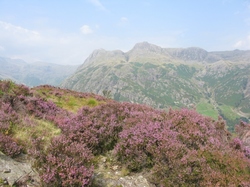 Glasswort and sea-purslane, 28 August
Glasswort and sea-purslane, 28 August
 Glasswort and sea-purslane, 28 August Glasswort and sea-purslane, 28 August South Walney salt-marsh is a tease, its specialized habitat a challenge. I pore over images to untangle the weave, to tease out, to trace a strand to its origin. Strong sunlight casts shadows onto rock, throwing structure into sharper definition. And I like the aesthetic of shadow-shapes. The glassworts of salt-marsh morph and shape-shift and colour harmonies are so subtle that I long to return to follow them through the autumn. Very variable- that’s glasswort of Walney salt-marsh and annual seablite of shingle. Beautiful too. Back-lit, those wriggles of glasswort are translucent in soft and delicate hues.
0 Comments
 Yellow Horned Poppy, Pier and Piel Castle Yellow Horned Poppy, Pier and Piel Castle Looking out across the salt-marsh toward Piel Castle, I picture the convict Able Magwitch hauling himself up from deep gullies, masked in mud. A mystery ship appears, and slowly turns away- the Hulks, the convict ship from which Magwitch has escaped. But the day lacks any hint of the menace Dickens conjures in 'Great Expectations.' Sunlight plays on the castle ruins and glints on the water channels and clouds cast fleeting shadow. Little egrets gleam in the sun and there are waders foraging in shallow water about the old pier. Red shank are calling and a solitary greenshank appears.  Sundew and sphagnum moss by Bleamoss Beck Sundew and sphagnum moss by Bleamoss Beck Carnivorous sundew often lurks in spaghnum moss, a trap for unwary insects. Each leaf is spiked with translucent hairs tipped with a sticky dew. Water drains off Wrynose Fell, down toward Bleamoss Beck where sundew in a surround of golden sphagnum overhangs the rushing water. I have many an image like this one- it's a plant whose habit interests me. Unlike carnivorous butterwort, whose pale leaves show well into autumn, sundew leaves little trace. Sunlight glints on water-tracks threading across Bleamoss and it's irresistible. And the sun gleams on mystery clots of carmine too. What a find!  Fruit-bodies of Bog asphodel, Narthecium ossifragum 18 August Fruit-bodies of Bog asphodel, Narthecium ossifragum 18 August The yellow stars of bog asphodel flowers are soon over, but the fruit-bodies are as lovely and they last far longer. Fragile and bone-grey, a scatter of last summer's plants still shows as a skeletal presence. Back- lit the newest seed-heads glow in the sun. Delving the flora of blanket bog, I can infer what is to come, what I might discover. I love the transitions of colour, of the season. Cross-leaved heath is the erica of boggy hollows and its flowers fade to gold. In mid-August the first flowers of devil's bit scabious appear. And the long blades of common cotton grass take on a deep wine- red.  Lingmoor Tarn with bogbean Lingmoor Tarn with bogbean A splash of colour trailing down a rock on Lingmoor Fell caught Alastair’s eye and was a puzzle. We took a closer look. A club moss, with spore-cases called cones. Long, creeping stems and upright stalks with cones pale and bright as candles. I knew I’d seen this clubmoss here before so I trawled my photo archive and found Stagshorn clubmoss on 15 August 2010, without those distinctive yellow-green cones. So, an interesting find.  The Langdale Pikes from Lingmoor Fell 18 August 2016 The Langdale Pikes from Lingmoor Fell 18 August 2016 Lingmoor Fell is a hymn to heather as the name tells: heather, ling, calluna vulgaris. A hot and hazy day in mid-August brings out its sweet fragrance and palette of colours. The disposition of heather; that's my focus today. The different ericas are alive with pollinating insects, with dragonflies beside Lingmoor Tarn and where sun glistens water trickling off the fell. Approaching the high point of Lingmoor Fell, a serpentine wall runs like a fair-ground ride over the ridge and Brown How appears, its eastern flank resplendent with heather.  Autumn gentian, Felwort, Gentianella Amarella Autumn gentian, Felwort, Gentianella Amarella Autumn gentian is a lovely little flower, easy to overlook. This morning’s bright blue skies and strong sun saw the flowers open. In a sequence of overcast days the petals can remain resolutely closed, the flower bud inconspicuous on its darkish stem. White flowers were more abundant than blue- never the glorious blue of flowers in the high mountains but good to discover. There must have been overnight dew because down amongst the grasses the spiders had been busy and it’s the season to find their webs, looking like Olympian rings. All that Olympic success is enough to go to anyone’s head. What do you think?  Red-tailed bumblebee on ragwort Red-tailed bumblebee on ragwort Ragwort nectar attracts a host of insects. I find bumble bees, hoverflies, an antler moth and peacock butterfly. The antler moth is named for the pale, antler-like markings on its wings. The tiny red-tailed bumble nectaring on heather looks weighed down by pollen baskets on either hind leg. Once it’s back at the colony how does it download the pollen? At this season heather and ragwort seem most attractive to insects.  Sunrise at the Mushroom Shelter Sunrise at the Mushroom Shelter Friends of the Lake District invited us to meet at sunrise on Scout Scar to mark the extension of the National Park. In the darkness before dawn we made our way to The Mushroom Shelter- a toposcope and a landmark. Breakfast sizzled beneath its dome and coffee warmed us. An Alborada from Cumbria Gaitaband welcomed sunrise which lit the folk gathered beneath the Mushroom Shelter. I reflect on children who came here at sunrise over a hundred years ago, and on their experience. |
Archives
July 2024
Categories
All
|

 RSS Feed
RSS Feed